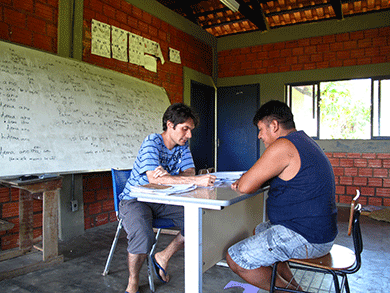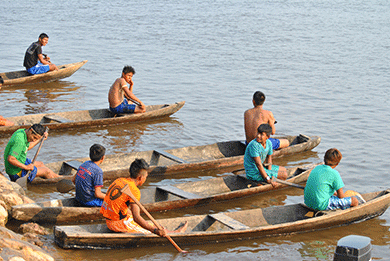
Research and documentation on a highly endangered indigenous language from Amazon
by Thiago Castro
The Djeoromitxí language is an endangered indigenous language spoken in the state of Rondônia in Northwest Brazil, in the Brazil-Bolivia border area. There are a total of 204 Djeoromitxí people, who share the area with nine other ethnic groups that speak distinct, and largely unrelated, languages. Frequent interaction with other groups, interethnic marriage, contact with the non-Indian community, and various other factors have led most of the indigenous people to speak more Portuguese than their mother language. This linguistic diversity of languages and language families in the same community is favorable to the superimposition of languages.
Djeoromitxí is now highly endangered, despite being the major indigenous language in the community and one of the few indigenous languages of instruction in the indigenous village. Currently, there are about 50 Djeoromitxí speakers, most of them more than 35 years old. They do not speak Djeoromitxí on a day-to-day basis, nor is the language being transmitted to the younger generations. However, its description and documentation can provide relevant data to the typological inventory of languages of the world. Furthermore, it is possible to use documentation of the Djeoromitxí language and culture as a source of ethnographic data.
The primary goal of my trip last summer, partially supported by the summer graduate student research grant from CLLAS, was to continue the documentation of the Djeoromitxí language and culture. I visited two indigenous villages and worked mainly with three indigenous teachers and two elder people. As methodology, I performed several elicitation sessions with native speakers, using interviews and wordlists. I analyzed 45 minutes of text recordings. In addition, I obtained more than 1 ours of linguistic data, using stimulus materials developed by the Max Planck Institute in Germany.
With the help of native speakers of the indigenous language, I transcribed some of the material collected during the summer along with texts collected previously. These texts will form the basis for the elicitation of morphosyntactic properties of the language. A recommended method for circumventing the unreliability of grammaticality is creating minimal pairs or sets by replacing words or morphemes of the sentences from the texts. For example, if one wants to know how singular and plural are distinguished or if there is an agreement between certain constituents in relation to the number, one can withdraw a sentence of text with a single argument and ask, “What would you say if it was not just one but several X?”

My project mainly deals with primary data, which constitute the core of language documentation and include audio or video of a communicative event—a narrative, a conversation, and so on—but also annotations. All the primary data produced so far from my work on Djeoromitxí is stored in the language archive at Museu Goeldi in Brazil, which contains metadata of the projects and sessions. The metadata about the projects includes information about the project(s) under which the data were collected. The metadata about the session comprises information such as: name of the session (the session identified within the general corpus); when and where the data were recorded; who was recorded and who else was present at the time; who made the recording and what kind of recording equipment was used; indication of the quality of the data; a brief description of the content of the session, which includes the topic of what was recorded, what kind of communicative event was documented, whether narrative, conversation, song, and so on; and links between different files, which together constitute the session—for example, a media file and a file containing transcription.
My research project is a long-term commitment. I am interested in training members of the indigenous community to work in language documentation and revitalization. All the Djeoromitxí indigenous teachers know how to write consistently in the language. With more training in transcription and technology usage, they may be able on their own to carry out work on language projects. I believe that the linguistic research can be produced simultaneously with the community’s interests and necessities. Although there have been some revitalization efforts, with Djeoromitxí being one of the indigenous languages taught in the community school, this is far from enough to allow Djeoromitxí to be efficiently transmitted. In the last several years, the indigenous teachers have been asking for improvement of the pedagogical material that already exists, which includes school-prime books (books to teach people how to write and read in the indigenous language) and a dictionary. I am certain that my project can generate results that will be helpful for inclusion in these types of materials.
—Thiago Castro is a PhD student at the UO Department of Linguistics. His main goal in the doctoral degree is to write a grammar of the indigenous language and join efforts with the community to revitalize the language.
